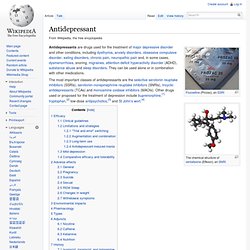

Selective serotonin reuptake inhibitor. Selective serotonin re-uptake inhibitors or serotonin-specific reuptake inhibitor [ 1 ] ( SSRIs ) are a class of compounds typically used as antidepressants in the treatment of depression , anxiety disorders , and some personality disorders .

SSRIs are believed to increase the extracellular level of the neurotransmitter serotonin by inhibiting its reuptake into the presynaptic cell , increasing the level of serotonin in the synaptic cleft available to bind to the postsynaptic receptor . They have varying degrees of selectivity for the other monoamine transporters , with pure SSRIs having only weak affinity for the noradrenaline and dopamine transporter .
Medical uses [ edit ] The main indication for SSRIs is major depressive disorder (also called "major depression", "clinical depression" and often simply "depression"). Depression [ edit ] Generalized anxiety disorder [ edit ] Obsessive compulsive disorder (OCD) [ edit ] Tricyclic antidepressant. Tricyclic antidepressants ( TCAs ) are heterocyclic chemical compounds used primarily as antidepressants .

The TCAs were first discovered in the early 1950s and were subsequently introduced later in the decade; [ 1 ] they are named after their chemical structure , which contains three rings of atoms . The tetracyclic antidepressants (TeCAs), which contain four rings of atoms, are a closely related group of antidepressant compounds.
In recent times, the TCAs have been largely replaced in clinical use in most parts of the world by newer antidepressants such as the selective serotonin reuptake inhibitors (SSRIs), serotonin-norepinephrine reuptake inhibitors (SNRIs) and the norepinephrine reuptake inhibitors (NRIs) like reboxetine which typically have more favorable side-effects profiles, though they are still sometimes prescribed for certain indications . List of TCAs [ edit ] The TCAs include the following agents which are predominantly serotonin and/or norepinephrine reuptake inhibitors :
Monoamine oxidase inhibitor. Monoamine oxidase inhibitors ( MAOIs ) are chemicals which inhibit the activity of the monoamine oxidase enzyme family .

They have a long history of use as medications prescribed for the treatment of depression . They are particularly effective in treating atypical depression . [ citation needed ] They are also used in the treatment of Parkinson's Disease and several other disorders. Indications [ edit ] In the past, MAOIs were prescribed for those resistant to tricyclic antidepressant therapy. [ citation needed ] Newer MAOIs such as selegiline (typically used in the treatment of Parkinson's disease) and the reversible MAOI moclobemide provide a safer alternative [ 4 ] and are now sometimes used as first-line therapy. However, these substances are not always as effective as their predecessors. [ citation needed ] Mechanism of action [ edit ] Reversibility [ edit ] The early MAOIs inhibited monoamine oxidase irreversibly. Antidepressant. Antidepressants are drugs used for the treatment of major depressive disorder and other conditions, including dysthymia, anxiety disorders, obsessive compulsive disorder, eating disorders, chronic pain, neuropathic pain and, in some cases, dysmenorrhoea, snoring, migraines, attention-deficit hyperactivity disorder (ADHD), substance abuse and sleep disorders.

They can be used alone or in combination with other medications. The most important classes of antidepressants are the selective serotonin reuptake inhibitors (SSRIs), serotonin–norepinephrine reuptake inhibitors (SNRIs), tricyclic antidepressants (TCAs) and monoamine oxidase inhibitors (MAOIs). Other drugs used or proposed for the treatment of depression include buprenorphine,[1] tryptophan,[2] low-dose antipsychotics,[3] and St John's wort.[4] Efficacy[edit] To establish efficacy, an antidepressant must show that it can produce a therapeutic effect for the condition for which it is taken. Clinical guidelines[edit] Long-term use[edit]